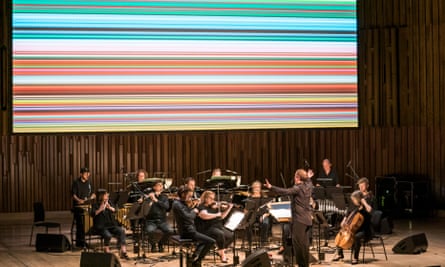This collaboration between the New York composer Steve Reich and the German painter Gerhard Richter sees both of them stepping slightly outside of their respective comfort zones. Reich’s music is rather more nuanced and irregular than normal, while Richter’s contribution, made with film director Corinna Belz, is a slowly evolving piece of optical art projected on a large screen above the 14-piece ensemble.
Richter’s film is based on a 2012 book of computer-generated art called Patterns, which halved and mirrored his paintings to create kaleidoscopic images. As Reich’s music starts, the screen displays a series of horizontal stripes – like a Bridget Riley painting, or a piece of Missoni knitwear – which are gradually disrupted by vertical lines, creating fractal patterns. They keep subdividing, symmetrically, to the point where the image on the screen looks like a Persian rug, or one of those three-dimensional Magic Eye pieces, or a symmetrical version of one of Richter’s scraped and squeegeed abstract canvases. Ultimately the visuals start to resemble Rorschach blots, and the audience will start to impose their own connections between the audio and visuals.
Such interpretation is helped by the irregular nature of Reich’s music here. Using a tight ensemble – a string quartet, three flutes, three clarinets, two vibraphones and two pianos – his composition is quite different from the chugging minimalism with which he is associated, which is usually so mechanical and orderly. Here it keeps shifting time signature; there are discordant flute lines that take an age to resolve; there are angular chord changes and sudden shifts in pace that occasionally resemble Stravinsky’s neoclassical works. Sometimes, when these musical handbrake turns are accompanied by a sudden change in colour, or a shifting shape, you start to suspect that this has been rigorously time-coded, even though it hasn’t.

This is the European premiere of a project that emerged at the Shed, a new, half-a-billion-dollar arts space in Manhattan. It was curated by the venue’s chief executive and artistic director Alex Poots, the enthusiastic Scottish impresario who founded the Manchester international festival, and joins other audacious multimedia Poots projects, such as when Damon Albarn and Rufus Wainwright moved into opera, or the documentary maker Adam Curtis collaborated with Massive Attack.
Like many Poots collaborations, there are moments when Reich/Richter can be wonderfully disorientating and hypnotic. However, if there’s a problem with this kind of multimedia collision, it’s that one art form can sometimes detract from the other. One recalls the poet Paul Valery, who said that setting a poem to music was as confusing as illuminating a painted picture through a stained-glass window (“Music’s beauty lies in its translucency; poetry’s in reflection. Light is implicit in one, and implied in the other”). Richter’s process, wherein detailed paintings become partially obscured by scraped-on opaque layers, work best as atemporal pieces that one can linger over at leisure: immersive works that audiences will stare at, transfixed, for many minutes. Likewise, Reich’s mesmeric minimalism has the power to disrupt time and space; to shimmer and glisten in a way that often paints images. Put them together, though, and they both lose their unique properties. There are points in tonight’s short show when you long for contemplative silence to appreciate Richter’s art, or want to shut your eyes to enjoy Reich’s music.

Comments (…)
Sign in or create your Guardian account to join the discussion